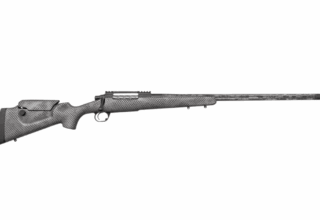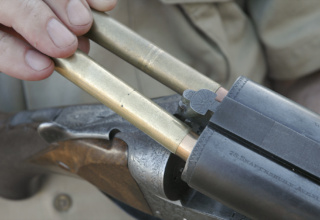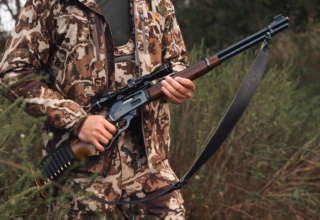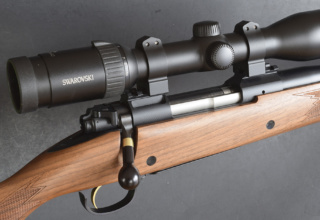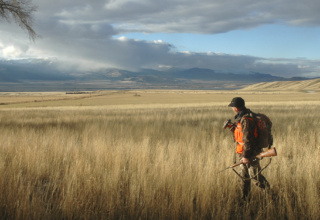Hunting, you’ll find game where there’s no support for your rifle and no time to move. What then?
by Wayne van Zwoll
We spied them at dawn and scrambled through Kalahari sand up a ridge to catch them, quartering across a basin. Wheezing from the climb, I jammed my arm in the sling and dropped prone. The Mauser’s front sight jitter-bugged on the bull. He paused. The 9.3 bullet flew 140 yards, slamming into his shoulder.
Later, on the hilly stretch of desert that had yielded that gemsbok, dawn would put me on the trail of four eland bulls. Cresting another rise, again with pounding pulse, I came upon the last. He gave me no time for prone. The best I could manage was a quick crouch. A 250-grain soft-nose felled him at 80 yards.
Few hunters practice firing from field positions. Fewer hurry their shots at targets. They zero from a bench and check loads from a bench. Tight groups satisfy.

But game country doesn’t grow benches. Shots often come when you can’t find even a rock or a tree to steady the rifle. But in many places, you can still lie down. A low shooting position brings your center of gravity close to earth and affords lots of ground contact. You’re among the blessed if your rifle wears a bipod and the beast waits until you deploy it. For hunting rifles, a Harris bipod is hard to beat. It’s sturdy, easily clipped to a swivel stud and quick to use. Long-legged versions extend for sitting. Twin studs? Use the front for the bipod, the rear for a sling.

Keep bipod legs as short as practical. When prone, get aggressive with the rifle. Planting the bipod and leaning into it, the rifle butt snug in your shoulder, you “load” the bipod forward. If you plan to use a bipod on a hunt, zero your rifle from it. Shifts in forend support can affect point of impact. Practice firing uphill to ensure you have enough eye relief. Chances are, you’ll want to slide that scope forward.
My rifles don’t wear bipods. Competitive shooting has endeared me to the sling. It’s helped me poke many dime-size, 50-meter groups in rimfire matches. Without a sling, I’d have sprayed bullets all over the paper.
For 47 years, I’ve used a Brownells Latigo Sling afield. It usually keeps my prone wobble inside 2 MOA. As with a bipod, I bend my right leg to shift mid-body support from belly to left hip. Bone to earth, pulse-bounce goes away.

Natural point of aim matters. You want the rifle to relax onto the target. A few sessions dropping prone to aim at a small mark will help you fall into a position that won’t need correcting on the ground. Muscling the rifle with your arms, you court a miss. Let bones support the rifle. They have no pulse, and they don’t tire. Bones are the building blocks of a solid platform in any position!
Prone, your left elbow belongs almost directly under the forend, pressed solidly into the earth by the rifle’s weight. Adjust the sling’s leading section, or shooting loop, so it’s taut from the front swivel to just above your triceps, thus tugging the rifle into your shoulder. The sling must be slack from your arm to the rear swivel. If it isn’t, or if you’ve installed a carrying strap instead of a sling, you lose support up front while tension on the stock’s toe cants the rifle and pulls it away from your shoulder.

Prone is your go-to position when reeling in yardage across barren flats and peeking over bald ridges. I can’t recall killing a pronghorn or a caribou from any other position! It can also extend your view through woods. In Canadian bush, I bumped a moose that ran off, then paused, obscured by dense spruce. Peering under limbs, I spied an antler tip. One 80-yard shot, prone, from my Ruger in .300 RCM sufficed.
Besides steadying the rifle, prone can keep you from looking immediately like a hunter. In open forest, hunting elk, I heard a bull angling toward me. On hands and knees, I scurried to intercept. A .30-30 bullet to his chest from prone sent the six-point into cover as I reloaded on my belly, tipping the lever gun sideways to cycle it. Slowly, I crabbed to the side. When an alley opened to his ribs, I fired twice. He collapsed.
Cape buffalo are seldom shot from prone, but I tagged a bull that way. Dusk was hard upon us as we raced to catch animals we’d tracked most of an afternoon. Hoof-thumps pulled me up a rise, where I flopped prone as the beast crossed a slot in the thorn 90 yards out. Dust hung on the shoulder for an eye-blink after my shot. The beast lumbered in an arc, then dropped to my follow-up .375 solid.

Prone gets more appealing with age. The low sit that once favored me in competition is no easier now than a back-flip. But lying down is the way most of us leave our hunting gear to someone else. Prone becomes more natural, more relaxed. A natural, relaxed position is steadiest.
Sitting trumps prone when rocks, brush or the curve of a hill blocks a shot from prone. Arguably the most versatile hunting position, it has a smaller footprint than prone and is better adapted to uneven terrain. It makes your body tripod-steady. An open sit with knees up, tent-like, elbows in front of knees, heels spread comfortably, is the position for shooting from a slope across a draw. Lumbar muscles lock your arms against the flats of your knees. (Resting elbows atop knees won’t steady you; both are movable joints. Also, your back then has nothing to tug against.) Shifting your feet to spin on your fanny, you can follow a moving animal from this sit. Swiveling at the waist in a limited arc, you can make a moving shot.

The crossed-ankle position is popular in the National Match course, where riflemen drop to a sit from standing as 200-yard targets appear. A crossed-ankle sit puts your center of gravity lower than does an open sit. On broken ground, however, it doesn’t work as well because your feet aren’t spread to form a tripod base. Slopes can put you off balance. Again, the rifle steadies itself best if you lean well forward, elbows in front of knees.

Shooting three- and four-position bulls-eye matches, I used a crossed-leg sit, legs scissored under my torso. My calves on opposite insteps, I bent low, elbows overlapping knees, lumbar muscles pulling all together. Stretching legs and back for this position gets harder over time. If you plan to use it on hunts, practice it! Drop to a sit with a target identified. If your feet and fanny don’t instantly, naturally align the rifle, they weren’t “pointed right.” Shooting with a university team, I kept muscles stretched by studying from a crossed-leg sit, sometimes holding my 11-pound match rifle.

Kneeling and offhand? Only when you’re desperate! Topics for another time.


